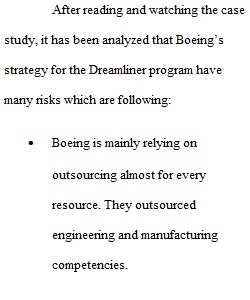


Q The new Boeing 787 Dreamliner aircraft was to be the pride of the fleet when first announced. Image Citation: https://www.maxpixel.net/static/photo/1x/Aircraft-Transport-Dreamliner-Jet-Boeing-The-Plane-3357762.jpg It was to change the way commercial aircraft would be designed and built going forward. With tremendous fanfare and excitement, Boeing was scheduled to debut the 787 Dreamliner in a test flight in August 2007 and then achieve first delivery in May 2008. But then the supply chain woes, technological issues and production interruptions began and much to the dissatisfaction of customers (and some hefty delivery penalties later), the plane deliveries were delayed years from original expectations. What went wrong? Perhaps almost everything. Boeing decided to outsource almost everything including many of the aspects considered core competencies such as engineering and manufacturing. Boeing then designed an extremely complex, and therefore inherently risky, network of over 50 international suppliers that did not operate as efficiently as intended. They changed major technological aspects of the plane including a game-changing switch from aluminum to carbon composite components. They encountered supply shortages ranging from bolts to inadequate flight control software. They encountered battery quality issues and electrical system failures that led to in-flight fires including their very first test flight. Let’s see what we can learn from the lessons afforded by Boeing's Dreamliner supply chain nightmare. In addition to your own research, watch the video and read the following two articles about the Boeing Corporation Dreamliner program. Watch this video on the delivery of the first 787: Video Citation: Al Jazeera Investigates - Broken Dreams: The Boeing 787 - Preview, Spetember 9, 2014, https://youtu.be/s0glSFfmeH4 Also Read these articles: https://www.supplychaindigital.com/scm/boeing-787-dreamliner-tale-terrible-supply-chain-management (Links to an external site.) https://www.seattletimes.com/business/boeing-787rsquos-problems-blamed-on-outsourcing-lack-of-oversight/ (Links to an external site.) Q1: What risks were associated with Boeing's strategy for the Dreamliner program? Q2: What would you have done differently in the design of the Supply Chain? Q3: Develop a SWOT Analysis for the hypothetical launch of a new Boeing aircraft – the 7OM7 Case Study Rubric Criteria Ratings Pts This criterion is linked to a Learning OutcomeApplication of Chapter Concepts to Case Study Example 10 to >7.0 pts Excellent Supports CS diagnosis and opinions with strong relevant arguments and well documented evidence; presents a balanced and holistic critical view; interpretation is both reasonable and objective. CS response shows evidence of knowledge and understanding of assigned reading and interactive exercises. Provides quality and quantity of relevant concepts applied to the specifics of the CS. Includes analytics, research, observation, ideas and recommendations, potential solutions and sensitivity analysis. Goes beyond the basic answers to the prompts and demonstrates thoroughness of responses by incorporating numerous chapter concepts. 7 to >5.0 pts Average Supports diagnosis, suggestions and opinions with limited reasoning and evidence; presents a somewhat one-sided or incomplete argument; demonstrates modest engagement of chapter concepts to the ideas presented. Makes appropriate but somewhat vague connections between identified issues/problems and concepts studied in readings, interactive exercises and/or lectures; demonstrates some command of the analytical tools studied; supplements case study with limited research. Answers to the prompts are basic and routine. 5 to >0 pts Poor CS response is light in content with little or no action suggested and/or inappropriate solutions proposed to the issues in the case study. Lacks suitable connection between the issues identified and the concepts studied in the readings and interactive elements; supplements case study, if at all, with incomplete research, documentation and citation of resources. Does not adequately answer all the CS prompts. 10 pts This criterion is linked to a Learning OutcomeContent - Relevance, analytical thought and expression of ideas/points 5 to >3.0 pts Excellent Identifies and demonstrates a sophisticated understanding of the main issues/problems/opportunities in the case study. Presents an insightful and thorough analysis of all identified issues/problems; includes all necessary supporting materials and/or calculations. 3 to >2.0 pts Sufficiently Average Identifies and demonstrates an average understanding of most of the issues/problems/opportunities. Presents a moderate analysis of most of the issues identified within the CS; May lack appropriate elaboration to express ideas/points. May be missing some support materials and/or necessary calculations. 2 to >0 pts Poor Identifies and demonstrates at or below minimum acceptable understanding of the issues/problems/opportunities within the CS. Lacks analytical fortitude, or responses are irrelevant Presents a superficial or incomplete analysis of the identified issues; omits supporting materials and/or necessary calculations. 5 pts This criterion is linked to a Learning OutcomeProfessionalism - Writing mechanics and formatting quality of written submittal 5 to >4.0 pts Impeccable - few to zero errors Demonstrates clarity, content flow and correctness; formatting is appropriate and writing is free of grammar and spelling errors. 4 to >2.0 pts Presentable Occasional grammar or spelling errors, however document offers a clear presentation of ideas; may lack organization or proper formatting. 2 to >0 pts Poorly presented - numerous errors Writing style is unfocused, difficult to follow, rambling, or contains serious/numerous errors; poorly organized or does not follow specified guidelines. 5 pts Total Points: 20 Rubric Case Study Rubric PreviousNext
View Related Questions